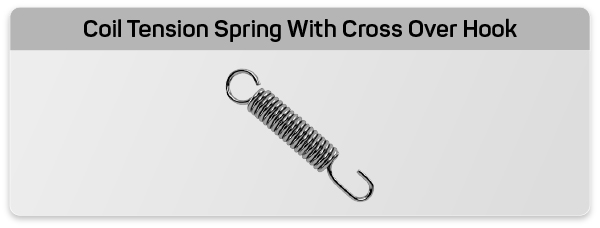Coil Tension Springs
Attention! Input results shown will be +/- 10% from middle value. Hint: The closer your min and max inputs are, the more accurate your results will be!
Attention! Input results shown will be +/- 10% from middle value. Hint: The closer your min and max inputs are, the more accurate your results will be!
Attention! Input results shown will be +/- 10% from middle value. Hint: The closer your min and max inputs are, the more accurate your results will be!
Definition:
Springs made by helically winding spring wire, keeping the coils tight one on top of the other, in order to produce tension.
Also known as extension springs.
Coil tension springs are used to be pulled apart when a load or force is applied. Once this force or load is released, the tension on the coil tension spring will make the coils shrink back to their original length. When using our online calculator, Spring Creator, you have the option to pick between four types of hooks; machine hooks, cross-over-center hooks, side hooks, or extended hooks. The option to put no hooks on coil tension spring is also available in case you are trying to experiment with a long length spring or perhaps you will be using a bolt to thread into the inner diameter of the coil tension spring to fasten it.

When changing the hook type on your spring while keeping the length inside hooks the same, the number of coils is affected. Machine hook lengths represent 75% of the inner diameter while cross over center and side hooks represent the full inner diameter of your coil tension spring. If you decide to switch from machine hooks to cross over or side hooks, you will have less coils which means your coil tension spring will be stronger. The formulas below will explain why.
Coil tension springs with machine hooks:
LIH - ID * 0.75 * 2 = BL
Length Inside Hooks – Inner Diameter * 0.75 * 2 = Body Length
BL ÷ WD – 1 = A/C
Body Length ÷ Wire Diameter – 1 = Active Coils
Example. You have a 2” length inside hooks on a coil tension spring spring with machine hooks. This spring also has an inner diameter of 0.5” and a wire diameter of 0.025”. Multiply the hook length of the machine hooks (75% of the inner diameter) by two (there are two hooks on the spring) and subtract that from the 2” length inside hooks.
LIH – ID * 0.75 * 2 = BL
2.000 - 0.5 * 0.75 * 2 = BL
2 .000 - 0.375 * 2 = BL
2.000 - 0.75 = BL
1.25 = Body Length
BL ÷ WD – 1 = A/C
1.25 ÷ 0.025 - 0.025 = A/C
50 – 1 = A/C
49 = Active Coils
Coil tension springs with cross over center or side hooks:
LIH – 2 ID’s = BL
Length Inside Hooks – 2 Inner Diameters = Body Length
BL ÷ WD – 1 = A/C
Body Length ÷ Wire Diameter - 1 Wire Diameter = Active Coils
Example. You have a 2” length inside hooks on a coil tension spring spring with side hooks. This spring also has an inner diameter of 0.5” and a wire diameter of 0.025”. Multiply the hook length of the machine hooks (inner diameter) by two (there are two hooks on the spring) and subtract that from the 2” length inside hooks.
LIH - 2 ID’s = BL
2.000 - 0.5 * 2 = BL
BL ÷ WD – 1 = A/C
1.000 ÷ 0.025 – 0.025 = A/C
40 – 1 = A/C
39 = Active Coils
Now that you have seen those examples, notice that both examples had the same dimensions yet we still had different results due to the hook type.






